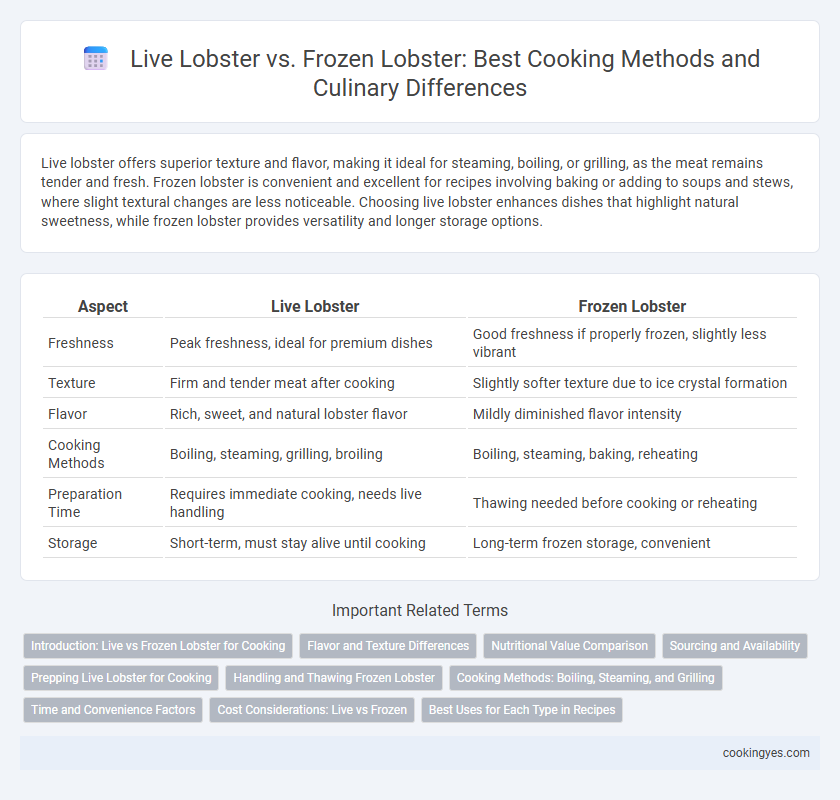Live lobster offers superior texture and flavor, making it ideal for steaming, boiling, or grilling, as the meat remains tender and fresh. Frozen lobster is convenient and excellent for recipes involving baking or adding to soups and stews, where slight textural changes are less noticeable. Choosing live lobster enhances dishes that highlight natural sweetness, while frozen lobster provides versatility and longer storage options.
Table of Comparison
| Aspect | Live Lobster | Frozen Lobster |
|---|---|---|
| Freshness | Peak freshness, ideal for premium dishes | Good freshness if properly frozen, slightly less vibrant |
| Texture | Firm and tender meat after cooking | Slightly softer texture due to ice crystal formation |
| Flavor | Rich, sweet, and natural lobster flavor | Mildly diminished flavor intensity |
| Cooking Methods | Boiling, steaming, grilling, broiling | Boiling, steaming, baking, reheating |
| Preparation Time | Requires immediate cooking, needs live handling | Thawing needed before cooking or reheating |
| Storage | Short-term, must stay alive until cooking | Long-term frozen storage, convenient |
Introduction: Live vs Frozen Lobster for Cooking
Live lobster offers superior texture and flavor due to minimal degradation before cooking, making it ideal for steaming, boiling, or grilling. Frozen lobster provides convenience and longer shelf life while retaining good taste when properly thawed and cooked, especially for recipes like lobster bisque or pasta. Choosing between live and frozen depends on cooking method, timing, and desired flavor intensity.
Flavor and Texture Differences
Live lobster offers superior flavor and texture due to its freshness, resulting in a sweeter, more delicate meat and firm, succulent texture that enhances cooking methods like steaming and boiling. Frozen lobster, while convenient, often loses some moisture during freezing and thawing, leading to a slightly less tender texture and a milder, less vibrant taste. Selecting live lobster is ideal for chefs and seafood enthusiasts seeking optimal sensory quality in dishes requiring precise cooking techniques.
Nutritional Value Comparison
Live lobster retains higher levels of essential nutrients such as omega-3 fatty acids, vitamins B12 and E, and minerals like zinc and selenium compared to frozen lobster. Freezing can cause a slight degradation in protein quality and a reduction in certain heat-sensitive vitamins, impacting the overall nutritional profile. Cooking methods for live lobster typically preserve more nutrients due to shorter cooking times and fresher meat quality.
Sourcing and Availability
Live lobster is typically sourced directly from coastal fisheries, ensuring freshness and a high-quality texture ideal for steaming or boiling. Frozen lobster, often flash-frozen at sea or shortly after harvest, provides year-round availability and convenience but may have a slightly altered texture suited for dishes like lobster bisque or lobster rolls. Availability of live lobster depends on season and location, whereas frozen lobster offers consistent supply regardless of harvesting seasons.
Prepping Live Lobster for Cooking
Preparing live lobster for cooking involves immediately placing the lobster in a bowl of ice water to numb it before handling, ensuring humane treatment and ease of preparation. Carefully twist off the claws and crack them with a lobster cracker or mallet while the lobster is still alive to maximize freshness and flavor. Removing the digestive tract and rinsing the lobster under cold water prevents grit in the final dish, enhancing the overall eating experience.
Handling and Thawing Frozen Lobster
Live lobster requires minimal handling and is typically cooked immediately by boiling or steaming to preserve freshness. Frozen lobster demands careful thawing in the refrigerator for 8-12 hours or under cold running water to maintain texture and flavor before grilling, baking, or sauteing. Proper thawing prevents bacterial growth and ensures even cooking, essential for optimal taste and safety.
Cooking Methods: Boiling, Steaming, and Grilling
Live lobster retains superior texture and flavor when boiled, as the fresh meat absorbs heat evenly, resulting in a tender, juicy bite. Steaming live lobster preserves its natural sweetness and moisture, offering a delicate taste unmatched by frozen variants that may lose quality through freezing. Grilling frozen lobster can be challenging due to uneven thawing, whereas live lobster grilled properly delivers a smoky, succulent experience with a crisp shell and tender meat.
Time and Convenience Factors
Live lobster requires immediate cooking after purchase to ensure freshness, typically within 24 hours, making it less convenient for long-term planning. Frozen lobster offers extended shelf life and can be thawed and cooked at any time, saving preparation time and allowing flexible meal scheduling. While live lobster may provide superior texture and flavor, frozen lobster enhances convenience and reduces time constraints in cooking.
Cost Considerations: Live vs Frozen
Live lobsters typically command higher prices due to the costs associated with maintaining their freshness and the complexities of transportation. Frozen lobsters offer a more budget-friendly alternative, benefiting from longer shelf life and reduced spoilage risks, which lowers overall expenses for retailers and consumers. When planning meals, understanding these cost differences helps determine the most economical choice without compromising on lobster quality.
Best Uses for Each Type in Recipes
Live lobster is ideal for steaming or boiling, ensuring tender meat for classic dishes like lobster bisque and lobster rolls. Frozen lobster excels in recipes that require pre-cooked meat such as lobster mac and cheese or lobster thermidor, offering convenience without sacrificing flavor. Using live lobster enhances texture in simple preparations, while frozen lobster suits complex recipes where lobster is combined with rich sauces or baked ingredients.
Live lobster vs Frozen lobster for cooking methods Infographic

 cookingyes.com
cookingyes.com